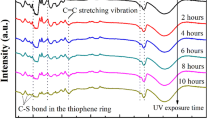Abstract
The effect of polydopamine coating on improving photostability of polyphenylene sulfide (PPS) fiber was investigated in detail. Due to strong adhesion ability and self-polymerization of dopamine in alkaline solution, the polydopamine could be easily coated on polyphenylene sulfide fiber under mild conditions. XPS, ATR-FTIR and SEM, which indicated the polydopamine coating was homogeneous, confirmed the polydopamine coating on PPS fiber. The UV-spectra analysis of polydopamine coating showed that it had a strong absorbance in ultraviolet wavelength and was very stable to it, which implied that the polydopamine was a potential photoprotection agent. 2,2-Diphenyl-1-picrylhydrazyl (DPPH) experiment further revealed that the PDA could quench free radicals, suggesting PDA was a good antioxidant. This scavenging ability of PDA might contribute to improving photostability of PPS fiber. Compared to pristine PPS fiber, the PPS fiber coated by polydopamine obviously had better photostability after ultraviolet irradiation according to mechanical test, which proved that polydopamine coating did improve the photostability of PPS fiber.















Similar content being viewed by others
References
Mckeen LW (2014) The effect of long term thermal exposure on plastics and elastomers. William Andrew, New York
Bhardwaj IS, Kumar V, Das A (1989) Studies of the thermal and crystallization behaviour of polyphenylene sulphide/polycarbonate blends. Thermochim Acta 144:165–172
Guo YL, Bradshaw RD (2009) Long-term creep of polyphenylene sulfide (PPS) subjected to complex thermal histories: the effect of nonisothermal physical aging. Polymer 50(16):4048–4055
Das PK, Deslauriers PJ, Fahey DR (1995) Photodegradation and photostabilization of poly(p-phenylene sulfide). Part 2. UV induced physicochemical changes. Polym Degrad Stab 48:11–23
Das PK, Deslauriers PJ, Fahey DR (1995) Photostabilization of poly(p-pheylene sulfide). Polym Degrad Stab 48:1–10
Wang S, Liu PQ, Ye GD (2010) Properties of carbon black modified polyphenylene sulfide fiber. China Synth Fiber Ind 33(3):5–8
Lee BP, Messersmith PB (2011) Mussel-inspired adhesives and coatings. Annu Rev Mater Res 41:99–132
Andersen NH, Harrington MJ, Messersmith PB (2011) pH-induced metal-ligand cross-links inspired by mussel yield self-healing polymer networks with near-covalent elastic moduli. PNAS 108:2651–2655
Faure E, Woisel P, Detrembleur C (2013) Catechols as versatile platforms in polymer chemistry. Prog Polym Sci 38:236–270
Liu YL, Ai KL, Lu LH (2014) Polydopamine and its derivatives materials: synthesis and promising applications in energy, environmental, and biomedical fields. Chem Rev 114:5057–5115
Forest SE, Simon JD (1998) Wavelength-dependent photoacoustic calorimetry study of melanin. Photochem Photobiol 68:296–298
Fu SR, Yu BW, Bai HW, Cheng F (2015) Combined effect of interfacial strength and fiber orientation on mechanical performance of short Kevlar fiber reinforced olefin block copolymer. Compos Sci Technol 108:23–31
Ho CC, Ding SJ (1997) Structure, properties and applications of mussel-inspired polydopamine. J Biomed Nanotechnol 10(10):3063–3084
Vogt AD, Han T, Beebe TP (1997) Adsorption of 11-mercaptoundecanoic acid on Ni (111) and its interaction with probe molecules. Langmuir 13:3397–3403
Jiang JH, Zhu LP, Li XL (2010) Surface modification of PE porous membranes based on the strong adhesion of polydopamine and covalent immobilization of heparin. J Membr Sci 34:194–202
Luo RF, Tang LL, Wang J (2013) Improved immobilization of biomolecules to quinone-rich polydopamine for efficient surface functionalization. Colloid Surf B 106:66–73
Xiong SQ, Wang Y, Hu ZM (2014) Polydopamine particles for next-generation multifunctional biocomposites. J Mater Chem A 2:7578–7587
Ju KY, Lee Y, Lee JK (2011) Bioinspired polymerization of dopamine to generate melanin-like nanoparticles having an excellent free-radical-scavenging property. Biomacromolecules 12:625–632
Acknowledgments
This study was supported by the Fundamental Research Funds for the Central Universities (XDJK2016C102/XDJK2016B020) and the National Natural Science Youth Foundation of China (Grant No. 51303150).
Author information
Authors and Affiliations
Corresponding author
Rights and permissions
About this article
Cite this article
Yang, X., Duan, L. & Ran, X. Effect of polydopamine coating on improving photostability of polyphenylene sulfide fiber. Polym. Bull. 74, 641–656 (2017). https://doi.org/10.1007/s00289-016-1735-y
Received:
Revised:
Accepted:
Published:
Issue Date:
DOI: https://doi.org/10.1007/s00289-016-1735-y




